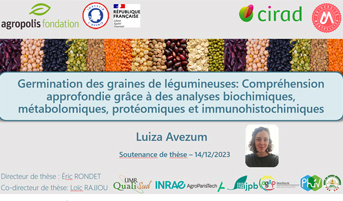Thesis defense: Luiza Avezum
Thursday, December 14th, 2 pm, CIRAD Montpellier
Germination in Pulse Seeds: Comprehensive Insights via Biochemical, Metabolic, Proteomic, and Immunohistochemistry analysis
Germination sensu stricto is a complex biological process that induces major metabolic changes and activates the accumulation of nutrients required for seedling growth. Germination begins with the absorption of water by the seeds and ends with the elongation of the radicle. During this process, the seeds accumulate free amino acids, vitamins, and sugars contributing to an enhanced nutritional profile. In addition, germination reduces the content of antinutritional factors (α-galactoside and phytate), which are responsible for reducing pulse consumption.
The aim of this study was to improve the nutritional profile of lentils and cowpeas by determining the optimal germination conditions. In addition, this study aimed to understand and identify the main metabolic pathways activated during germination. A preliminary study was conducted to analyze the effect of soaking on the α-galactoside content, with the purpose of differentiating the impact of soaking from that of germination. To evaluate the impact of the germination process, an experimental plan was developed to analyze the effects of temperature, light, and water content on the levels of thiamine, folates, amino acids, α-galactosides, and phytate. This initial exploratory phase was completed by metabolomic and proteomic which identified the key metabolites and enzymes driving the accumulation of amino acids and the initiation of sugar metabolism during germination. The final phase of the work focused on studying the spatial distribution of the compounds of interest (i.e. thiamine and folates), their evolution and the microstructural modifications induced during germination. The cross-sectional approach employed in this study enabled us to gain a better understanding of the microstructural changes, compound localization, and metabolic pathway orientation. This elucidation of the complex interactions that occur during germination not only improves our understanding of the processes but also lays the foundation for the food industry to adopt optimized germination processes for pulse processing.
Co-supervisor: Loïc Rajjou - AgroParisTech, INRAE, IJPB, Versailles
Co-supervisor: Eric Rondet - Université de Montpellier, CIRAD Montpellier, QualiSud,
Members of the jury:
> Paul Menut (Rapporteur) - AgroParisTech, Palaiseau
> Julia Buitink (Rapportrice) - INRAE Centre Angers-Nantes
> Mathilde Francin-Allani (Examinatrice) - INRAE Centre Angers-Nantes
> Valérie Micard (Examinatrice) - Institut Agro
To attend, contact Loïc Rajjou
Germination sensu stricto is a complex biological process that induces major metabolic changes and activates the accumulation of nutrients required for seedling growth. Germination begins with the absorption of water by the seeds and ends with the elongation of the radicle. During this process, the seeds accumulate free amino acids, vitamins, and sugars contributing to an enhanced nutritional profile. In addition, germination reduces the content of antinutritional factors (α-galactoside and phytate), which are responsible for reducing pulse consumption.
The aim of this study was to improve the nutritional profile of lentils and cowpeas by determining the optimal germination conditions. In addition, this study aimed to understand and identify the main metabolic pathways activated during germination. A preliminary study was conducted to analyze the effect of soaking on the α-galactoside content, with the purpose of differentiating the impact of soaking from that of germination. To evaluate the impact of the germination process, an experimental plan was developed to analyze the effects of temperature, light, and water content on the levels of thiamine, folates, amino acids, α-galactosides, and phytate. This initial exploratory phase was completed by metabolomic and proteomic which identified the key metabolites and enzymes driving the accumulation of amino acids and the initiation of sugar metabolism during germination. The final phase of the work focused on studying the spatial distribution of the compounds of interest (i.e. thiamine and folates), their evolution and the microstructural modifications induced during germination. The cross-sectional approach employed in this study enabled us to gain a better understanding of the microstructural changes, compound localization, and metabolic pathway orientation. This elucidation of the complex interactions that occur during germination not only improves our understanding of the processes but also lays the foundation for the food industry to adopt optimized germination processes for pulse processing.
Co-supervisor: Loïc Rajjou - AgroParisTech, INRAE, IJPB, Versailles
Co-supervisor: Eric Rondet - Université de Montpellier, CIRAD Montpellier, QualiSud,
Members of the jury:
> Paul Menut (Rapporteur) - AgroParisTech, Palaiseau
> Julia Buitink (Rapportrice) - INRAE Centre Angers-Nantes
> Mathilde Francin-Allani (Examinatrice) - INRAE Centre Angers-Nantes
> Valérie Micard (Examinatrice) - Institut Agro
To attend, contact Loïc Rajjou
Back

Luiza Avezum wins best presentation award at ICEF14 2023 conference, news IJPB 26/6/23